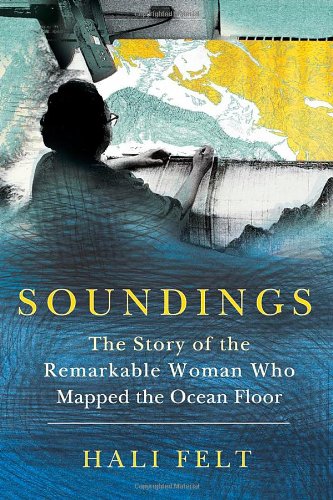Soundings: A Richly Detailed Prose Map of Marie Tharp’s Life and Legacy

History dislikes remembering science’s founding mothers. So you may have never heard of the mother of the mid-ocean ridge. She was one of the parents of plate tectonics. Her 100th birthday is today. And Hali Felt’s Soundings: The Story of the Remarkable Woman Who Mapped the Ocean Floor is the book you need to read about her.
Hali isn’t an earth scientist, but after immersing herself in Marie’s life and work, you’d never know it. She draws the birth of plate tectonics with as much skill and assurance as Marie drew her remarkable maps. But she doesn’t just tell a science story.
She tells the story of a little girl whose family migrated constantly due to her father’s soil science job. She shows Marie spending days tromping through fields with her daddy, helping him take sample and sometimes acting as scale for his photos. She traces Marie’s erratic journey through nearly two dozen schools, and how that constant change caused her to rely on herself because friends were always fleeting. She shows the close bonds Marie formed with her mother and father, and how they encouraged her to imagine and explore. The details are so carefully, vividly drawn you’re almost right there.
We’re there for the loss of her mother at fifteen, just after they’ve finally settled into a permanent home, and the subsequent return of her half brother, who also lost his mother young. They didn’t grow up together due to his living with his mother’s parents, but he becomes one of the anchors of her life. No matter where in the world Marie ends up, her father and brother are there for her to return to.
Hali takes us through Marie’s erratic college career, where she chooses a new major every semester. She doesn’t accept the careers offered to women of her era: secretary, nurse, or teacher. WWII offers her a different path: the men are away, so women are needed to become geologists. She leaps at the chance. But those other majors, like art, become an integral part of her future success, Hali shows. Marie didn’t follow any well-worn grooves, and thus was able to visualize what no one else could.
She picks up math and drafting before moving to New York, and parleys those skills into a job at Columbia University. It’s there where she meets her partner, Bruce Heegan, and begins the work that will eventually see her play a central role in revolutionizing geology.
Hali does a phenomenal job here, explaining why advocating for continental drift was a career killer in the geosciences in America then. She shows Marie mapping the ocean floor, sounding by sounding, interpolating and extrapolating from existing data. She shows how Marie was able to visualize something humans had never been able to see as a whole. She takes us data point by point as Marie determines that the ridge others had merely glimpsed tiny portions of runs all down the center of the Atlantic. And she builds masterfully to Marie’s unanticipated discovery of the rift valley running down the center of the entire thing.
This is what made continental drift undeniable. And Marie recognized it for what it was, before any of the man she worked with dared accept it.
So we get to experience that revolution, right with the people who were there, who couldn’t have gotten there nearly so quickly or decisively without Marie’s maps showing them the undeniable truth. And then we get to experience the discovery that the Mid-Atlantic Ridge is just a segment of a globe-spanning ridge that runs through all the world’s oceans. We get to feel the awe and wonder of having it revealed for the first time.
There are details of how a scientific map is painted that will have you enthralled. The panoramic maps of the ocean floor that Marie and Bruce worked on with National Geographic were complex, enormous, and took years to complete. All while they were also fighting their institution for their autonomy (nothing quite like a dictatorial boss who decides that you didn’t give him enough credit and deference. Although there are ways of handling such bosses, but Marie and Bruce didn’t opt for the effective ways!).
Hali will nearly break your heart with Bruce’s untimely death and its effect on Marie. And she’ll break it again as the scientific world decides that Marie without Bruce can’t do groundbreaking work anymore, and rips their unfinished work from her hands without giving her a chance to prove that she’s eminently capable on her own.
The end of her life was spent securing their legacy. She wasn’t alone: she always had a devoted group of Tharpophiles there to work for and with her. Their interactions are delightful. And though, in the end, she dies alone, it’s clear that was by her choice. She was independent even when stuck in a hospital bed. And her Tharpophiles were there until the last night, then carried on, ensuring her maps and her papers were given the place in history they deserved. Hali draws them all so vividly that you almost feel you’re one of them.
This intensely researched, lovingly written book is a remarkable tribute to a remarkable woman, her partner, her people, and her critical contribution to the most important theory in geology. It’s the biography that Marie deserved. If you want to know who the mother of plate tectonics was, this is the book you need.
Happy birthday, Marie!

Rosetta Stones and Dana Hunter’s Unconformity wouldn’t be possible without you! If you like my content, there are many ways to show your support.
This website is a member of the Amazon Affiliates program. I get a small commission when you use my affiliate link to make a purchase.
Thank you so much for your support!




